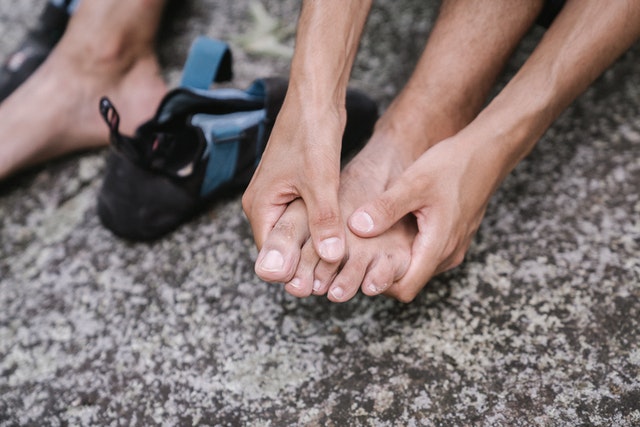If you're like most people, you spend a great deal of time on your feet. This includes working, going to school, and spending time with friends and family.
So it's not surprising that foot problems can occur, especially if you have diabetes. In this post, we'll discuss some signs and complications of foot issues, as well as treatment options.
Complications can have a huge impact on your life and well-being, but there are some simple things you can do to avoid them. Diabetes is not only about blood sugar levels in the body; it also involves many other aspects like nutrition, weight loss, and exercise as well as behavior changes that may lead to complications such as heart disease or kidney failure.
We hope this information will help you get the treatment you need and prevent further complications.
Do I have diabetic foot?
Diabetic foot is a condition defined by high blood sugar levels in the bloodstream that can damage the nerves and other tissues of the feet. Below are signals that you might be suffering from diabetes feet.
You have symptoms of diabetic neuropathy
Diabetic neuropathy is a common complication of diabetes. It affects about 80% of people with diabetes. It can occur in any part of the body, but it’s most often seen in the feet.
Diabetic neuropathy can be caused by poor blood flow to the nerves and high blood sugar levels, which causes nerve damage. Symptoms of neuropathy include numbness, tingling, and pain in your feet or legs that may spread up into your arms and hands. The condition may also cause burning pain along with loss of feeling or sensation, especially when you touch your toes.
The symptoms can be so severe that they interfere with daily activities such as walking and standing. On the other hand, the symptoms may be mild depending on how well your body processes sugar (glycemic control).
Some people also have a loss of muscle strength or coordination that affect their ability to walk properly. If you’re experiencing any of these symptoms as well as other ones like foot pain or ankle swelling, you should contact your doctor immediately to see if there is anything they can do to help with your condition.
Your doctor or podiatrist will check for these symptoms during a physical exam as part of routine diabetes care. Treatment options include medications that help lower blood sugar levels and over-the-counter pain relievers such as acetamin.
Diabetic neuropathy can be treated by proper foot care and early detection so that symptoms are caught before they get worse.
Peripheral neuropathy is the most common form of diabetic neuropathy.
You have blisters on your feet
Frequent blistering of the feet can be a sign of diabetes. It is a condition that can affect your feet and legs if you have this disease. Diabetic foot blistering can occur due to poor circulation in the extremities, leading to an increase in moisture and friction.
It also occurs when the blood vessels in your foot are damaged by high levels of sugar in your blood (hyperglycemia). High levels of glucose in the bloodstream damage these tiny capillaries, which leads to tissue death.
This type of blistering or ulceration that appears on the bottom side of your feet, as well as heels, is often mistaken for athlete's foot or fungus because it looks similar to those two conditions but can be easily treated with over-the-counter medication like Zyrtec and Arava cream.
It is important to know about blister symptoms so that you will be able to take the right action when they appear on your body. You can do this by applying lotion on your feet regularly, which helps reduce redness, dryness, and irritation.
You have diabetic calluses
Diabetic calluses are common in people with diabetes. These calluses form due to reduced blood flow and poor circulation, which leads to skin breakdown.
These calluses can be hard or soft depending on how much damage has been done by the feet of a person suffering from diabetic conditions. People who have had problems with their feet such as ulcers or corns will often develop these calluses because they cannot get rid of them without medical intervention
This can lead to severe problems like infection, ulcers, and gangrene. You must take care of your calluses regularly with a pumice stone or an emery board to prevent these diseases from developing further.
You have diabetic ulcers
A diabetic ulcer is a skin condition that can cause pain and ulceration in the feet. The problem occurs when there is too much sugar in the blood, which can lead to nerve damage.
These symptoms make people think they have something more serious than a simple cut or blister on their feet. Yet, it is a skin infection and proper treatment is needed.
The ulcer can be a very painful condition that can cause red, itchy skin. It is important to have your feet checked regularly by a doctor, and if you notice any ulcer on the foot then it should be taken seriously. You should also monitor your feet routinely at home.
You have foot gangrene
Gangrene is a condition in which gangrene bacteria invade and damage tissues of the body. It can be caused by diabetes, chronic wounds, pressure sores and frostbite.
Diabetic gangrene occurs when there is excessive blood sugar in the body that leads to tissue death due to infection or lack of oxygen supply.
It can affect any part of the body. Gangrene-causing bacteria often enter an area through small cuts or abrasions in the skin.
The gangrene process starts with microscopic wounds on your feet, which are then colonized by "anaerobic" (oxygen free) bacteria called pseudomonas aeruginosa. As these microorganisms multiply rapidly, they begin to produce toxins that destroy surrounding tissues and blood vessels. Gangrene develops if this process goes unchecked for too long as it spreads from your foot into other parts of your body such as toes, hands or arms.
You have diabetic toenails
Diabetic toenails are caused by a decrease in blood flow to the foot, which causes nails to become brittle and easily break. However, it is not clear whether this condition can lead to more serious conditions like nerve damage or ulcers.
Diabetic toenails are a common symptom of diabetes. When toenails become brittle and split, they can be painful and bleed easily. Diabetic toenails are often ignored until they begin to cause pain or infection.
However, when you see the warning signs of diabetic feet in your nails it’s time for action: Cut your nails straight across rather than curving them at the ends (this will prevent splitting).
It is important that you visit your doctor if you have any of these toenail symptoms.
Three Takeaways
- Symptoms of diabetes feet are quite common in people who are diabetic.
- Complications of diabetic foot can be serious, but there are treatments that can help improve the condition and help reduce the symptoms.
- Treatment options include lifestyle changes like eating a healthy diet and exercising regularly, as well as medication prescribed by your doctor.
Complications of Diabetic Foot Problems
The complications of diabetic foot problems are not limited to the loss of feeling in the feet or having poor circulation. Diabetic complications can lead to many other conditions as well. For example, swelling and fluid retention may cause joints and muscles in your legs to become stiffer and more painful than usual.
Your skin will be dry and itchy; you may also have foot ulcers or sores on your feet that won't heal properly. Severe cases may result in amputation of toes, feet, or limbs.
Amputation
Diabetic amputation is a serious complication that can occur in diabetics if foot problems are not controlled. It occurs when the foot becomes infected or damaged due to a lack of blood supply, which affects the nerves and skin.
If you are suffering from diabetic feet, then amputation is a viable option. Amputation is necessary if you cannot bear the pain of having a leg or foot that does not work properly due to infection and ulcers caused by diabetes complications. It also helps in preventing gangrene as well as amputating your limb at an early stage when it has lost most of its function.
Diabetes may result in peripheral artery disease or diabetic neuropathy, two conditions that raise the chances of needing amputation.
Can diabetes feet be cured?
There is no cure for diabetes feet, but there are treatments that can help reduce the symptoms. Treatment options include diabetes foot care products.
There are a few products specifically designed to help with diabetes foot care. These include diabetic socks, diabetic shoes, diabetic slippers, lotions, and bandages.
The best way to fix diabetic feet may vary depending on the individual's specific situation. However, some common approaches that may help address foot issues related to diabetes include:
- Treating any underlying medical issues that may be causing diabetes. This can include addressing high blood pressure, heart problems, and kidney issues.
- Taking measures to improve the diabetic condition. This includes lifestyle changes like eating a healthy diet, drinking adequate amounts of water, exercising regularly, getting a good night's sleep, and quitting smoking. You may also consider taking blood sugar supplements, multivitamins, and herbs. Your doctor may also prescribe medication.
Bottom line
If you or someone you know is struggling with foot problems related to diabetes, then you're not alone. In this blog post, we've outlined some basic steps you can take to reduce the pain and suffering that you're experiencing.
By consulting with your doctor, you can get the treatment and lifestyle changes that will help improve your condition.
Programs that can make a difference naturally
Controlling and beating diabetes doesn't just depend on eating right and exercising. It takes an entire mindset shift and plan that can be challenging to develop on your own.
Fortunately, many coaching, mentoring and guidance opportunities are available at affordable costs. Here are revies of a few of our favorites:
FAQs about diabetes foot problems
Below are answers to frequently asked questions we hear about diabetic foot issues and care.
What complications come with diabetes feet?
Complications from diabetes include foot complications such as athlete’s foot, dermatitis herpetiformis, diabetic neuropathy, foot ulcers, gangrene, diabetic retinopathy, blisters, calluses, and other skin problems.
Why is it so important to address underlying medical issues that may be causing diabetes?
Diabetes is a serious, life-threatening disease that can be caused by many underlying medical issues. If left untreated, diabetes can lead to other health problems, such as heart disease, stroke, amputation, and blindness. By addressing the underlying medical issues that may be causing diabetes, people with the condition are more likely to receive the care they need and live long lives.
What are some common treatments that can help improve the condition of diabetic feet?
Some common treatments include:
- Regular foot care, including flushing out of feet with warm water and soap, brushing and cutting of toenails, and filing any cuts or sores on the feet.
- Diabetic shoes, socks, and slippers
- Insulin therapy may be recommended to help lower blood sugar levels
- Surgical procedures such as foot amputation may be required
Which lifestyle changes can help reduce the symptoms of diabetes feet?
There is no definitive answer to this question. Some lifestyle changes that may help reduce the symptoms of diabetes feet include eating a balanced and healthy diet, maintaining a healthy weight, getting sufficient exercise, avoiding smoking and drinking alcohol, and practicing good foot hygiene.
How might medication prescribed by your doctor help improve the condition of diabetic feet?
Medication can help improve the condition of diabetic feet by helping to lower blood sugar levels, reduce inflammation, and improve circulation. Alternatives include supplements, vitamins, herbs, and teas.




